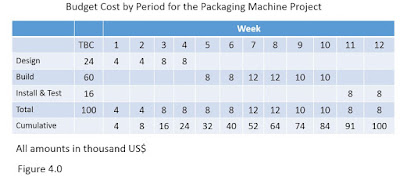The Project budgeting process involves two steps. First, the project cost estimate is allocated to the various work packages in the project work breakdown structure. Second, the budget for each work package is distributed over the duration of the work package so that's possible to determine how much of its budget should have been spent at any point in time.
1. Allocating the Total Budgeted CostAllocating total project costs for the various elements, such as Labor, Materials and Subcontractors to the appropriate work packages in the work breakdown structure will establish a Total Budgeted Cost (T.B.C) for each work package. There are two approaches to establishing the T.B.C for each work package. One is a top down approach , in which Total Project Cost (For labor, materials and so forth) are reviewed in relation to the work scope for each work package, and a proportion of the total project cost is allocated to each work package.
The other is a bottom up approach, which is based on an estimate of the costs for the detailed activities associated with each work package. The project costs is usually estimated when the proposal for the project is prepared, but detail plans are not usually prepared at this time. At the start of the project, however, detailed activities are defined and a network plan is developed. Once detailed activities have been defined, time, resource, and cost estimates can be made for each activity. The T.B.C for each work package will be the sum of the costs of all the activities that make up that work package.
Figure 1.0 illustrates the allocation of costs to individual work packages in the work breakdown structure for a $ 600,000 project. The amount allocated to each work package represents the T.B.C for completing all the activities associated with the work package. Whether the top down or the bottom up approach is used to establish the total budgeted cost for each work package, when the budgets for all the work packages are summed, they can not exceed the total project budgeted cost.
Figure 3.0 shows the work breakdown structure with the total budgeted cost for each work package.
2. Developing the Cumulative Budgeted Cost
Once a total budgeted cost has been established for each work package, the second step in the project budgeting process is to distribute each T.B.C over the duration of its work package. A cost is determined for each period, based on when the activities that make up the work package are scheduled to be performed. When T.B.C for each work package is spread out by time period, it can be determined how much of the budget should have been spent at any point in time. This amount is calculated by adding up the budgeted costs for each time period up to that point in time. This total amount, known as the Cumulative Budgeted Cost (CBC), is the amount that was budgeted to accomplish the work that was scheduled to be performed up to that point in time. The CBC is the baseline that will be used in analyzing the cost performance of the project.
For the packaging machine , Figure 4.0 shows how the T.B.C for each work package is spread over the time periods, based on the estimated durations shown in Figure 2.0, also shown is the period by period budgeted cost for the entire project, as well as its cumulative budgeted cost (CBC). Figure 4.0 indicates that $ 32,000 was budgeted to accomplish the work that was scheduled to be performed through week 5. The Period over which budgeted costs are spread usually are determined by the earliest start and finish times for the activities in the baseline project schedule (adjusted to take into account resource leveling or resource limited scheduling)
With the CBC value's, its possible to draw a cumulative budgeted cost curve to illustrate budgeted expenditure over the duration of project. Figure 5.0 shows the cumulative budgeted cost curve for the packaging machine project. Although the table in Figure 4.0 and the cost curve in Figure 5.0 display cumulative budgeted cost for the total project, a similar table and curve can be made for each work package, if desired.
The CBC for the entire project or each work package provides a baseline against which actual cost and work performance can be compared at any time during the project. It would be misleading to merely compare actual amounts expended to the total budgeted cost for the project or work package, as cost performance will always look good as long as actual costs are below the T.B.C.





Thanks for sharing such wonderful information about Project Budgeting, Project Budgeting in Toronto
ReplyDelete